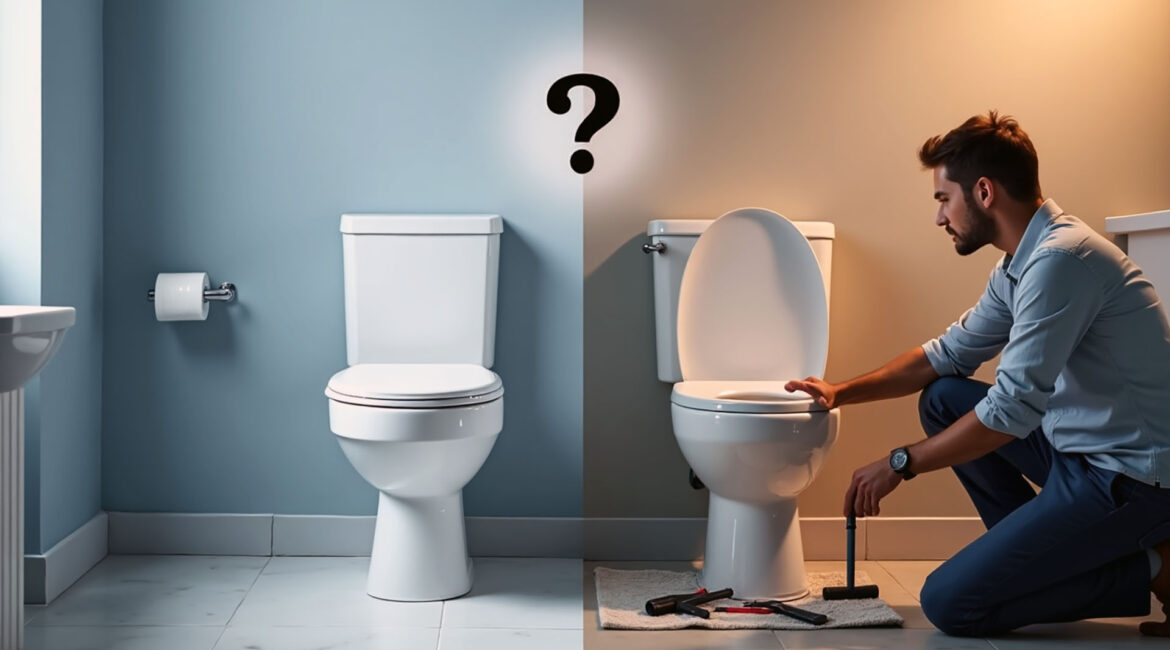Every homeowner knows that moment. The toilet won’t stop running, water leaks mysteriously, or that worrying wobble just doesn’t go away. These common plumbing problems lead to a vital decision – should you replace the toilet or try to fix it?
A quick fix might look like the obvious choice at first glance. The right decision between fixing and replacing can save you time and money down the road. This piece walks you through everything you need to know about toilet repair or replacement. You’ll learn about typical lifespans and what different options might cost.
We’ll help you find the best solution for your situation. The core factors that shape this home maintenance decision matter a lot. You’ll discover useful maintenance tips, warning signs to watch for, and practical ways to think over both repair and replacement choices.
Table of Contents
- Understanding Your Toilet’s Lifespan
- Essential Toilet Maintenance Tips
- Critical Repair vs Replace Factors
- Investment Considerations
- Final Thoughts
Understanding Your Toilet’s Lifespan
Your toilet’s lifespan plays a vital role in deciding between repairs and replacement. Modern toilets are durable, and their longevity depends on factors every homeowner should know.
Average Toilet Longevity
A residential toilet typically lasts 10 to 15 years. With proper care, some units can serve you well for up to 20 years. This substantial difference in lifespan shows how quality maintenance can extend your toilet’s useful life.
Factors Affecting Toilet Performance
These elements determine how well your toilet performs through the years:
- Material Quality: Premium porcelain and resilient internal parts add years to life
- Usage Frequency: More household traffic means faster wear
- Water Quality: Hard water leaves mineral deposits that damage components
- Installation Quality: The original setup prevents future problems
- Maintenance Routine: Quick repairs and regular care keep it running longer
Signs of Age-Related Issues
Your toilet sends clear signals when it nears the end of its service life. Multiple clogs without misuse point to internal wear. Constant running water or strange noises suggest failing parts, while small cracks or leaks near the base indicate structural problems.
Your water bills can reveal hidden issues. Unexpected increases might mean concealed leaks or poor performance. A wobbly toilet could mean floor damage from ongoing seepage. This situation needs a professional plumber’s attention right away.
Mineral buildup and repeated flushing problems often show up in older toilets, especially with hard water. These issues usually get worse and might make replacement a better choice than more repairs.
Essential Toilet Maintenance Tips
Toilet maintenance is the life-blood of preventing repairs that can get pricey and keeping your toilet working at its best. A toilet that’s managed to keep in good shape works better and helps your home’s entire plumbing system stay healthy.
Preventive Care Guidelines
Your toilet needs regular care and attention to detail. Here’s everything you need to do to keep it running smoothly:
- Clean the bowl and rim jets monthly using mild cleaners
- Check water levels in the tank regularly
- Test the flush handle and flapper operation
- Inspect for any signs of leaks around the base
- Monitor the shut-off valve’s functionality
Regular Inspection Checklist
A full monthly inspection helps you spot problems before they turn serious. Here are the key areas to look at:
- Tank components (flapper, fill valve, chain)
- Base stability and caulking condition
- Wax ring integrity
- Water supply line connections
- Bowl rim and jet cleanliness
Professional Maintenance Schedule
Regular home maintenance is significant, but professional servicing plays a vital part in making your toilet last longer. Experts suggest you schedule these inspections:
- Annual complete check-ups
- Bi-annual component testing
- Immediate inspection when unusual problems arise
Professional plumbers can spot subtle issues you might miss during routine checks. They have specialized tools and expertise to get a full picture of your toilet’s condition and fix what needs fixing.
Your toilet will work best when you avoid harsh chemical cleaners that can damage parts. Use gentle cleaning solutions and mechanical methods like plungers for minor clogs instead. Good maintenance prevents expensive repairs and helps you save on water bills by catching leaks early.
Note that keeping detailed records of maintenance and professional services helps. These records show patterns and help predict when parts might need replacement, making it easier to plan your budget for future repairs or replacement.
Critical Repair vs Replace Factors
The choice between fixing or replacing a toilet needs more than just comparing costs. Homeowners should assess safety, efficiency, and practical aspects to make the right decision.
Safety Considerations
Safety comes first when you assess a toilet’s condition. Any visible cracks in the porcelain spell trouble, no matter how tiny they seem. These hairline fractures only get worse and might lead to complete failure that causes major water damage. A toilet that wobbles could mean the floor underneath is damaged. This needs a professional to check it out quickly before structural problems develop.
Efficiency Ratings
Today’s toilets save much more water than older models. Here are the standard efficiency measures:
- Standard toilets (pre-1994): 13.2-26.5 liters per flush
- Federal requirement: 6.1 liters per flush
- High-efficiency models: 4.8 liters or less
- Dual-flush options: 3.0-4.9 liters per flush
The EPA says homeowners can save about CAD $194.32 each year on water bills by switching to a WaterSense-certified model. This means the original cost pays for itself within a few years.
Parts Availability
Finding parts becomes harder as toilets get older. Older models often need fixes, but their parts are hard to find or no longer made. Replacement is usually budget-friendly if repairs happen more than once every few months. New toilets come with standard parts that are accessible to more people and easier to maintain.
The toilet’s age and repair history should guide your decision. A toilet that needs multiple fixes in one year, plus poor efficiency, means replacement is your best bet. On top of that, new models offer better features like dual-flush systems and improved bowl designs that work better and need less maintenance.
Investment Considerations
Homeowners need to balance both immediate expenses and long-term benefits while looking at the financial side of toilet maintenance. A full picture helps them make the most economical decision that fits their needs.
The bigger picture goes beyond the original costs:
- Aging toilets need more repairs
- Efficient models cut water bills
- Maintenance costs go down
- Water damage risks decrease
Energy Rebates and Incentives
Local governments give substantial rebates to homeowners who upgrade to water-efficient toilets. The current programs offer:
| Rebate Type | Amount | Qualification |
| Dual-flush Installation | CAD $69.40 | WaterSense® certified |
| Low-flow Replacement | CAD $34.70 | 6L or less per flush |
| High-efficiency Upgrade | CAD $138.80 | 4.8L per flush |
These programs help cut down the original replacement costs and promote water conservation. Low-flow models can save about 30,000 liters of water each year.
Property Value Impact
New toilets and bathroom upgrades can boost your property value substantially. Real estate numbers show mid-range bathroom remodels bring an ROI of 54-60%. Buyers who care about the environment love modern, efficient toilets that also make bathrooms look better.
Money isn’t the only benefit:
- Houses sell faster
- Properties spend 15% less time on the market
- Energy efficiency ratings improve
- Better mortgage terms become possible
Smart choices in toilet upgrades lead to long-term savings. Many homeowners cut their bathroom maintenance costs by 25% over five years. Rebates and lower water bills often mean the new efficient toilet pays for itself through reduced utility and maintenance costs.
Final Thoughts
The right choice between toilet repair and replacement helps homeowners save money and avoid future headaches. Simple repairs might seem budget-friendly at first, but replacement becomes more economical when toilets show multiple problems or poor efficiency.
Modern toilets come with water conservation features and better design that can save hundreds of dollars on yearly utility bills. These savings plus available rebates and less maintenance needs offset a new unit’s cost.
Homeowners need to assess their situation by looking at their toilet’s age, repair history, and efficiency levels. The equipment’s life span and performance depend on proper maintenance, whatever choice you make. A well-maintained toilet works better, adds to property value and prevents water damage from getting pricey.getting pricey tomorrow. These choices line up with their budget, efficiency goals, and comfort needs.





